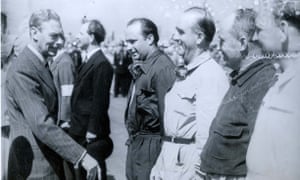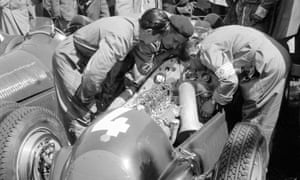Noise and smoke: how Silverstone gave F1 blast-off 70 years ago | Giles Richards | Sport
Opening with a roar that startled the Queen, Formula One’s inaugural race proved to be the beginning of a tale of sound and fury that has endured for 70 years. On 13 May 1950 the championship held its first race at Silverstone and the British Grand Prix has been on the F1 calendar ever since, its longevity reflecting how the sport has moved royalty and commoner alike.
Not long put to new use from its original purpose as a second world war airfield, Silverstone and F1 were intent on making their mark. Run by the Royal Automobile Club the race was named the “Grand Prix d’Europe, incorporating the British Grand Prix”. With King George VI, Queen Elizabeth and Princess Margaret in attendance some dubbed it “Royal Silverstone” in the hope it would become part of the sporting season.
It remains the only time the reigning monarch has attended a British motor race and rare documents held in the archive of the British Racing Drivers’ Club housed in the marvellous new Silverstone museum describe the extraordinary level of planning that went into the event, right down to the royal lap time. “It is hoped,” pre-race notes reveal, “that their majesties will drive round the track at approximately 15 miles an hour.”

The race programme speaks eloquently of a different era when explaining the sport to newcomers. “Smoking Permitted: Grand Prix drivers do not have to undergo strict physical training,” it reads. “Moderation in eating, drinking and smoking is sufficient, for motor racing is a test of brain rather than brawn.”
With 100,000 fans in attendance, most of whom had paid 7s 6d (the equivalent of 35.5p) for general entry, the race was ready to go and with the cars three and four abreast on the grid they took off. “The noise and the smoke took the Queen a trifle unawares as the mass start of a race does to those close to the course,” the report in Motorsport read. “Princess Margaret seemed to want to concentrate solely on what was happening and to regard conversation as merely incidental.”
The race lasted for almost two and a quarter hours over 70 laps and was dominated by the “Alfetta” Alfa Romeo 158s that ruled the era, winning 47 of the 54 races in which they were entered between 1938 and 1951. Alfa, whose cars had been driven to Silverstone illegally on public roads from Banbury, had a formidable lineup in Giuseppe Farina, Juan Manuel Fangio and Luigi Fagioli, with the British driver Reg Parnell as their fourth driver.

The rest of field were largely Maseratis, including one driven by Thai royalty in Prince Bira, and supercharged 4-litre Talbot-Lagos. Ferrari were notable by their absence, the only team ever present in F1 since 1950 were still preparing their cars for the next round at Monaco.
Farina led from the off and Parnell’s car was quickly recognisable from the smashed radiator grill incurred when a hare ventured into its path. Fangio battled with Farina for the lead until he damaged an oil pipe and retired but Alfa secured a 1-2-3, with Farina, Fagioli and Parnell. The Talbot of Yves Giraud-Cabantous was more than two laps back in fourth.
Alfa were in complete control that season winning every race bar the Indy 500, a timely reminder a single dominant team is not new to the sport. Farina would go on to take the inaugural F1 drivers’ championship from Fangio.

It had been a day to remember for local boy John King who recalled events for Silverstone museum’s oral history project in 2017. King had stumbled across the racing by accident. “We didn’t know anything about grand prix cars,” he recalled. “I was going home, we heard this noise and when I got through the hedge that was Copse Corner and there was a car parked up on the inside. They’d stopped going round so I shot across and it happened to be a blue Talbot Lago. That was the first racing car I’d ever seen.”
King returned on raceday. He vividly remembers the sight of the cars gathered on the startline. “You’ve never seen anything like it in all your life. The atmosphere was fantastic. People had come with their old vans and built a platform up on top. It was marvellous, like a great big club atmosphere.”

The huge crowd had made the event but brought the associated difficulties familiar to fans 70 years later. A correspondent to Motorsport complained the toilets were “nothing short of disgusting” and the magazine criticised the traffic congestion that would blight Silverstone until recent years.
F1, however, could not have wished for a better start. It had touched a chord and while a monarch never made it back, for others it started a lifelong love affair. King joined the Silverstone Racing Club and attended grands prix until his death in 2018.

